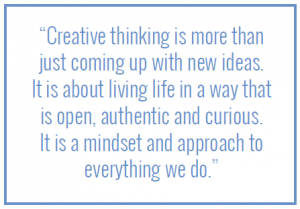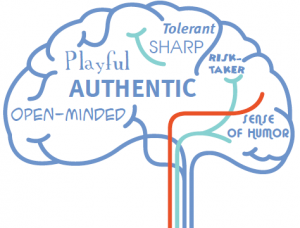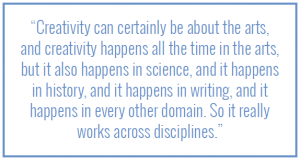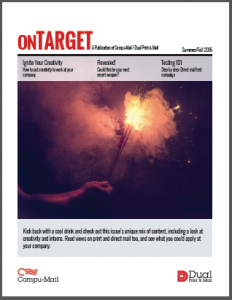43,688 people from 184 countries learned how to ignite their creativity this past winter. Why not you?
Dr. Cyndi Burnett, Assistant Professor of Creative Studies at SUNY Buffalo State, co-taught “Ignite Your Everyday Creativity” in February and March of this year. Offered as a MOOC (Massive Open Online Course) through the Coursera platform, the teaching team enjoyed an unprecedented opportunity to share their expertise with people around the world. The International Center for Studies in Creativity at Buffalo State is the world’s oldest degree-granting program in creativity and home of the first Master of Science degree in Creativity.
Dr. Burnett sat down with us recently to talk about creativity – and how we can all access and use creativity in both the workplace and everyday life.
What Is Creativity?

A commonly accepted universal definition of creativity, developed by Mo Stein, is that “Creativity is the generation of novel and useful ideas.” Another researcher, Mel Rhodes, found that creativity actually fell into four categories: the Creative Person, the Creative Process, the Creative Environment, and the Creative Product.
For Burnett, creativity is really centered on the Creative Person, “If you are a creative person and you are curious and open-minded, then that’s where creativity really begins.”
Being a Creative Person
The first step in being a creative person is to believe that you are creative. For the skeptics out there, Burnett explains, “Have you solved a problem in the last week that you didn’t have a solution for, without using Google? Guess what? You’re creative.” Research shows that just starting with the belief that you are creative enables you to further develop as a creative person.

Some of the characteristics that tend to be associated with being a creative person include open-mindedness, an ability to listen to ideas without judgment, and an ability to tolerate ambiguity, complexity or uncertainty. Creativity is hard work. It goes beyond knowledge acquisition to develop your thinking further, by going into creation. Other important characteristics revolve around the ability to think about things in different ways – for example, to project into the future something that doesn’t yet exist or to look at things in different ways, from multiple perspectives.
Burnett cautions though that being authentic to your creative self is critically important. “Your creativity would look much different than my creativity.…We have to focus on how we feel the most creative, not how other people are being creative.”
Why You Should Care About Creativity
Think you’re not a creative person or that creativity doesn’t matter? Artsy people don’t have a corner on the creativity market.

Creativity is often traditionally viewed as “expression,” but there is a second way to view it – as “improving upon things.” In the world of the arts, it’s often about expression, but in other domains, it’s about improving upon things. That is still considered creative, and that piece of creativity is essential.Do you ever need to improve upon things in your job, or even in your personal life?
Approaching a challenge creatively can help improve a process or system, the way a team works together, or how a business markets itself. If you don’t work effectively to create positive change, you’ll just stay where you are, instead of evolving towards the future. And Burnett reminds us, “You don’t need to do arts and crafts to be creative.”
Creativity in the Workplace
Our world of rapid change and technological advancement requires new ideas to better adapt to that change and continue to improve into the future. In fact, in a 2010 IBM study, global CEOs ranked creativity as the factor most crucial for success.
When asked why creativity is important in the workplace, Burnett suggests that you need look no further than companies like Kodak and Blockbuster, which offer great cautionary tales of why you need to constantly be thinking ahead and trying to “project into the future a vision that doesn’t yet exist for your organization.”
“By using creativity and coming up with new and useful ways that you might maximize on the strengths of your organization then you are more likely to be profitable in the future,” explains Burnett.
The speed of progress in the world today makes being a creative person even more important to long-term success. Applying creative process to business decision-making can make the difference in determining what kind of contribution your organization can make, and even how profitable it can be in five or ten years. What new things can you create to help you stay profitable?
Ready to inject some creativity into your everyday life? Burnett’s seen creativity practices transform business, make progress towards solving global issues, improve relationships, and make better parents. There’s no better time than today to embrace your own authentic creativity.
Want to delve deeper into creativity?
- Check out the companion article on the Dual Print & Mail site: Be A Creativity Booster: 5 Easy Ways to Bring Creative Thinking into Your Team’s Next Meeting
- The Buffalo State MOOC course on creativity referenced in this article will soon be available free on-demand through Coursera.
- The International Center for Studies in Creativity at Buffalo State also offers degree programs in a traditional classroom setting and via distance learning.
- Follow Dr. Cyndi Burnett on Twitter or Facebook.

This article originally appeared in our Summer/Fall 2015 issue of OnTarget, a Compu-Mail publication full of print and marketing news and ideas.





